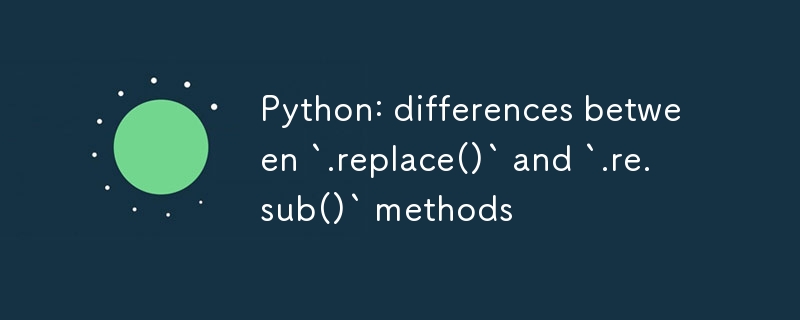Python:「.replace()」與「.re.sub()」方法的差異
發佈於2024-08-25

介紹
Python中的.replace()方法和.re.sub()函數都用於替換部分字串,但它們具有不同的功能和用例。以下是它們之間的根本差異:
-
模組與使用情境:
-
。代替():
- 屬於str類。
- 用作字串物件的方法。
- 語法:str.replace(old, new, count=-1)
- 範例: 'hello world'.replace('world', 'Python') 結果為 'hello Python'。
-
。代替():
-
.re.sub():
- 屬於re模組(正規表示式)。
- 用作 re 模組的函數。
- 語法:re.sub(pattern, repl, string, count=0, flags=0)
- 範例:re.sub(r'\bworld\b', 'Python', 'hello world') 結果為 'hello Python'。
-
模式匹配:
-
。代替():
- 僅支援簡單的字串比對。
- 不能使用正規表示式或複雜模式。
- 如果未指定計數,則替換所有出現的子字串。
-
。代替():
-
.re.sub():
- 支援正規表示式,允許複雜的模式匹配。
- 可以根據字元類別、重複和分組等模式進行匹配和替換。
- 允許使用反向引用並可以處理更複雜的替換。
-
更換彈性:
-
。代替():
- 僅限於用另一個固定子字串取代固定子字串。
- 沒有高級替換功能,例如捕獲組或條件替換。
-
。代替():
-
.re.sub():
- 允許使用捕獲組進行動態替換。
- 取代字串 (repl) 可以引用模式中的符合群組。
- 可以使用函數作為替換,這允許基於匹配進行複雜且動態的替換。
-
表現:
-
。代替():
- 簡單替換通常更快,因為它不涉及模式匹配。
-
。代替():
-
.re.sub():
- 由於正規表示式處理的開銷,通常比 .replace() 慢。
範例
使用 .replace():
text = "The quick brown fox jumps over the lazy dog"
result = text.replace("fox", "cat")
print(result) # Output: The quick brown cat jumps over the lazy dog
使用.re.sub():
import re text = "The quick brown fox jumps over the lazy dog" pattern = r'\bfox\b' replacement = "cat" result = re.sub(pattern, replacement, text) print(result) # Output: The quick brown cat jumps over the lazy dog
.re.sub() 的高階範例:
import re text = "The quick brown fox jumps over the lazy dog" pattern = r'(\b\w \b)' # Matches each word replacement = lambda match: match.group(1)[::-1] # Reverses each matched word result = re.sub(pattern, replacement, text) print(result) # Output: ehT kciuq nworb xof spmuj revo eht yzal god
總之,使用 .replace() 進行簡單直接的子字串替換,並在需要正規表示式的強大功能和靈活性來進行基於模式的替換時使用 .re.sub()。
版本聲明
本文轉載於:https://dev.to/doridoro/python-differences-between-replace-and-resub-methods-1cfj?1如有侵犯,請洽[email protected]刪除
最新教學
更多>
-
 如何在沒有圖像的 Outlook 電子郵件中建立圓角?在沒有圖像的 Outlook 中設定圓角樣式使用 CSS 在電子郵件用戶端中建立圓角可以非常簡單。但是,使用 CSS border-radius 屬性的傳統方法在 Microsoft Outlook 中不起作用。在設計具有圓角元素的電子郵件時,此限制提出了挑戰。 不用擔心,有一個解決方案可以讓您在 ...程式設計 發佈於2024-11-06
如何在沒有圖像的 Outlook 電子郵件中建立圓角?在沒有圖像的 Outlook 中設定圓角樣式使用 CSS 在電子郵件用戶端中建立圓角可以非常簡單。但是,使用 CSS border-radius 屬性的傳統方法在 Microsoft Outlook 中不起作用。在設計具有圓角元素的電子郵件時,此限制提出了挑戰。 不用擔心,有一個解決方案可以讓您在 ...程式設計 發佈於2024-11-06 -
 如何在Python中高效比較字典中相等的鍵值對?比較字典是否相等的鍵值對在Python中,比較字典以檢查鍵值對是否相等是一項常見任務。一種方法是迭代字典並使用 zip 和 iteritems 方法比較每一對字典。然而,還有一些替代方法可以提供更好的程式碼優雅性。 其中一種方法是使用字典理解來建立僅包含共享鍵值對的新字典。代碼如下:shared_i...程式設計 發佈於2024-11-06
如何在Python中高效比較字典中相等的鍵值對?比較字典是否相等的鍵值對在Python中,比較字典以檢查鍵值對是否相等是一項常見任務。一種方法是迭代字典並使用 zip 和 iteritems 方法比較每一對字典。然而,還有一些替代方法可以提供更好的程式碼優雅性。 其中一種方法是使用字典理解來建立僅包含共享鍵值對的新字典。代碼如下:shared_i...程式設計 發佈於2024-11-06 -
 如何在 PHP 中使用數組函數向左旋轉數組元素?在PHP 中向左旋轉數組元素在PHP 中旋轉數組,將第一個元素移動到最後一個元素並重新索引數組,可以使用PHP 的array_push() 和array_shift() 函數組合來實現。 PHP 函數:PHP 沒有專門用於旋轉的內建函數數組。但是,以下程式碼片段示範如何模擬所需的旋轉行為:$numb...程式設計 發佈於2024-11-06
如何在 PHP 中使用數組函數向左旋轉數組元素?在PHP 中向左旋轉數組元素在PHP 中旋轉數組,將第一個元素移動到最後一個元素並重新索引數組,可以使用PHP 的array_push() 和array_shift() 函數組合來實現。 PHP 函數:PHP 沒有專門用於旋轉的內建函數數組。但是,以下程式碼片段示範如何模擬所需的旋轉行為:$numb...程式設計 發佈於2024-11-06 -
 如何解決Java存取檔案時出現「系統找不到指定的路徑」錯誤?解決Java 中遇到「系統找不到指定的路徑」時的檔案路徑問題在Java 專案中,嘗試存取文字時遇到錯誤來自指定相對路徑的檔案。此錯誤是由於 java.io.File 類別無法定位指定路徑而產生的。 要解決此問題,建議從類別路徑中檢索文件,而不是依賴文件系統。透過這樣做,您可以消除相對路徑的需要,並確...程式設計 發佈於2024-11-06
如何解決Java存取檔案時出現「系統找不到指定的路徑」錯誤?解決Java 中遇到「系統找不到指定的路徑」時的檔案路徑問題在Java 專案中,嘗試存取文字時遇到錯誤來自指定相對路徑的檔案。此錯誤是由於 java.io.File 類別無法定位指定路徑而產生的。 要解決此問題,建議從類別路徑中檢索文件,而不是依賴文件系統。透過這樣做,您可以消除相對路徑的需要,並確...程式設計 發佈於2024-11-06 -
 Laravel 中的 defer() 函數如何運作?Taylor Otwell 最近宣布了 Laravel 中的新函數 defer()。這只是對 defer() 函數如何運作以及使用它可能遇到的問題進行非常基本的概述。 找出問題 還記得您曾經需要從 API 獲取某些內容,然後在幕後執行一些用戶不關心但仍在等待的操作的路由嗎?是的,我們都至少經歷過一...程式設計 發佈於2024-11-06
Laravel 中的 defer() 函數如何運作?Taylor Otwell 最近宣布了 Laravel 中的新函數 defer()。這只是對 defer() 函數如何運作以及使用它可能遇到的問題進行非常基本的概述。 找出問題 還記得您曾經需要從 API 獲取某些內容,然後在幕後執行一些用戶不關心但仍在等待的操作的路由嗎?是的,我們都至少經歷過一...程式設計 發佈於2024-11-06 -
 在 Python Notebook 中探索使用 PySpark、Pandas、DuckDB、Polars 和 DataFusion 的資料操作Apache Iceberg Crash Course: What is a Data Lakehouse and a Table Format? Free Copy of Apache Iceberg the Definitive Guide Free Apache Iceberg Crash ...程式設計 發佈於2024-11-06
在 Python Notebook 中探索使用 PySpark、Pandas、DuckDB、Polars 和 DataFusion 的資料操作Apache Iceberg Crash Course: What is a Data Lakehouse and a Table Format? Free Copy of Apache Iceberg the Definitive Guide Free Apache Iceberg Crash ...程式設計 發佈於2024-11-06 -
 Vue + Tailwind 和動態類我最近在做的一個專案使用了Vite、Vue和Tailwind。 使用自訂顏色一段時間後,我遇到了一些困惑。 在模板中添加和使用自訂顏色不是問題 - 使用 Tailwind 文件使該過程非常清晰 // tailwind.config.js module.exports = { theme:...程式設計 發佈於2024-11-06
Vue + Tailwind 和動態類我最近在做的一個專案使用了Vite、Vue和Tailwind。 使用自訂顏色一段時間後,我遇到了一些困惑。 在模板中添加和使用自訂顏色不是問題 - 使用 Tailwind 文件使該過程非常清晰 // tailwind.config.js module.exports = { theme:...程式設計 發佈於2024-11-06 -
 端對端(E 測試:綜合指南端到端测试简介 端到端(E2E)测试是软件开发生命周期的重要组成部分,确保整个应用程序流程从开始到结束都按预期运行。与专注于单个组件或几个模块之间交互的单元或集成测试不同,端到端测试从用户的角度验证整个系统。这种方法有助于识别应用程序不同部分交互时可能出现的任何问题,确保无缝且无错误的用户体验。 ...程式設計 發佈於2024-11-06
端對端(E 測試:綜合指南端到端测试简介 端到端(E2E)测试是软件开发生命周期的重要组成部分,确保整个应用程序流程从开始到结束都按预期运行。与专注于单个组件或几个模块之间交互的单元或集成测试不同,端到端测试从用户的角度验证整个系统。这种方法有助于识别应用程序不同部分交互时可能出现的任何问题,确保无缝且无错误的用户体验。 ...程式設計 發佈於2024-11-06 -
 可以在 Go 結構標籤中使用變數嗎?在Go 結構體標籤中嵌入變數Go 的結構體標籤通常用於註釋和元數據,通常涉及簡單的字符串文字。但是,使用者可能會遇到在這些標籤中需要動態或計算值的情況。 考慮以下結構,其中帶有為 JSON 封送註解的「類型」欄位:type Shape struct { Type string `json:&...程式設計 發佈於2024-11-06
可以在 Go 結構標籤中使用變數嗎?在Go 結構體標籤中嵌入變數Go 的結構體標籤通常用於註釋和元數據,通常涉及簡單的字符串文字。但是,使用者可能會遇到在這些標籤中需要動態或計算值的情況。 考慮以下結構,其中帶有為 JSON 封送註解的「類型」欄位:type Shape struct { Type string `json:&...程式設計 發佈於2024-11-06 -
 如何增強 Visual Studio 的建置詳細程度以實現深入洞察?熟悉 Visual Studio 的建造詳細程度需要全面了解 Visual Studio 建置過程背後的複雜細節?別再猶豫了! 雖然使用 vcbuild 不會產生所需的詳細輸出,但 Visual Studio 的設定中隱藏著一個解決方案。採取以下簡單步驟即可解鎖大量資訊:導覽至 Visual Stu...程式設計 發佈於2024-11-06
如何增強 Visual Studio 的建置詳細程度以實現深入洞察?熟悉 Visual Studio 的建造詳細程度需要全面了解 Visual Studio 建置過程背後的複雜細節?別再猶豫了! 雖然使用 vcbuild 不會產生所需的詳細輸出,但 Visual Studio 的設定中隱藏著一個解決方案。採取以下簡單步驟即可解鎖大量資訊:導覽至 Visual Stu...程式設計 發佈於2024-11-06 -
 開發者日記# 誰寫的?有個想法困擾著我。也許,我們無法識別它,但日復一日,我們周圍越來越多的人工智慧生成的內容。 LinkedIn 或其他平台上的有趣圖片、影片或貼文。我對帖子的媒體內容沒有疑問(很容易識別它何時生成、從庫存中獲取或創建),但我對帖子的內容表示懷疑。幾乎每次我讀一篇文章時,我都會想這是誰寫的?是作者分享了...程式設計 發佈於2024-11-06
開發者日記# 誰寫的?有個想法困擾著我。也許,我們無法識別它,但日復一日,我們周圍越來越多的人工智慧生成的內容。 LinkedIn 或其他平台上的有趣圖片、影片或貼文。我對帖子的媒體內容沒有疑問(很容易識別它何時生成、從庫存中獲取或創建),但我對帖子的內容表示懷疑。幾乎每次我讀一篇文章時,我都會想這是誰寫的?是作者分享了...程式設計 發佈於2024-11-06 -
 哪一種方法計算資料庫行數較快:PDO::rowCount 或 COUNT(*)?PDO::rowCount 與COUNT(*) 效能在資料庫查詢中計算行數時,選擇使用PDO:: rowCount 和COUNT(*) 會顯著影響效能。 PDO::rowCountPDO::rowCount 傳回受最後一個 SQL 語句影響的行數。但是,對於 SELECT 語句,某些資料庫可能會傳回...程式設計 發佈於2024-11-06
哪一種方法計算資料庫行數較快:PDO::rowCount 或 COUNT(*)?PDO::rowCount 與COUNT(*) 效能在資料庫查詢中計算行數時,選擇使用PDO:: rowCount 和COUNT(*) 會顯著影響效能。 PDO::rowCountPDO::rowCount 傳回受最後一個 SQL 語句影響的行數。但是,對於 SELECT 語句,某些資料庫可能會傳回...程式設計 發佈於2024-11-06 -
 PART# 使用 HTTP 進行大型資料集的高效能檔案傳輸系統让我们分解提供的HTML、PHP、JavaScript和CSS代码对于分块文件上传仪表板部分。 HTML 代码: 结构概述: Bootstrap for Layout:代码使用 Bootstrap 4.5.2 创建一个包含两个主要部分的响应式布局: 分块上传部分:用于...程式設計 發佈於2024-11-06
PART# 使用 HTTP 進行大型資料集的高效能檔案傳輸系統让我们分解提供的HTML、PHP、JavaScript和CSS代码对于分块文件上传仪表板部分。 HTML 代码: 结构概述: Bootstrap for Layout:代码使用 Bootstrap 4.5.2 创建一个包含两个主要部分的响应式布局: 分块上传部分:用于...程式設計 發佈於2024-11-06 -
 比較:Lithe 與其他 PHP 框架如果您正在為下一個專案探索 PHP 框架,很自然會遇到 Laravel、Symfony 和 Slim 等選項。但是,是什麼讓 Lithe 與這些更強大、更知名的框架區分開來呢?以下是一些突出 Lithe 如何脫穎而出的注意事項。 1. 輕量級與性能 Lithe 的設計重點在於輕量級...程式設計 發佈於2024-11-06
比較:Lithe 與其他 PHP 框架如果您正在為下一個專案探索 PHP 框架,很自然會遇到 Laravel、Symfony 和 Slim 等選項。但是,是什麼讓 Lithe 與這些更強大、更知名的框架區分開來呢?以下是一些突出 Lithe 如何脫穎而出的注意事項。 1. 輕量級與性能 Lithe 的設計重點在於輕量級...程式設計 發佈於2024-11-06 -
 程式設計風格指南:編寫簡潔程式碼的實用指南在过去的五年里,我一直在不断尝试提高我的编码技能,其中之一就是学习和遵循最推荐的编码风格。 本指南旨在帮助您编写一致且优雅的代码,并包含一些提高代码可读性和可维护性的建议。它的灵感来自于社区中最受接受的流行指南,但进行了一些修改以更适合我的喜好。 值得一提的是,我是一名全栈 JavaScript 开...程式設計 發佈於2024-11-06
程式設計風格指南:編寫簡潔程式碼的實用指南在过去的五年里,我一直在不断尝试提高我的编码技能,其中之一就是学习和遵循最推荐的编码风格。 本指南旨在帮助您编写一致且优雅的代码,并包含一些提高代码可读性和可维护性的建议。它的灵感来自于社区中最受接受的流行指南,但进行了一些修改以更适合我的喜好。 值得一提的是,我是一名全栈 JavaScript 开...程式設計 發佈於2024-11-06
學習中文
- 1 走路用中文怎麼說? 走路中文發音,走路中文學習
- 2 坐飛機用中文怎麼說? 坐飞机中文發音,坐飞机中文學習
- 3 坐火車用中文怎麼說? 坐火车中文發音,坐火车中文學習
- 4 坐車用中文怎麼說? 坐车中文發音,坐车中文學習
- 5 開車用中文怎麼說? 开车中文發音,开车中文學習
- 6 游泳用中文怎麼說? 游泳中文發音,游泳中文學習
- 7 騎自行車用中文怎麼說? 骑自行车中文發音,骑自行车中文學習
- 8 你好用中文怎麼說? 你好中文發音,你好中文學習
- 9 謝謝用中文怎麼說? 谢谢中文發音,谢谢中文學習
- 10 How to say goodbye in Chinese? 再见Chinese pronunciation, 再见Chinese learning

























